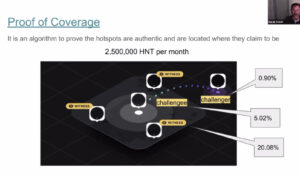Proof of Coverage is the mechanism to distribute most of the 2.5 million NHT’s minted every month. Helium invented POC as a way to authenticate Hotspots and make sure they are “where they say they are.”
There are a few key roles that hotspots play in Proof of Coverage.
Challenger– A role of one hotspot plays in sending out a “challenge,” basically a math problem, to POC signal, or beacon, l to other hotspots in the area. Challengers earn .9% of the HNT mined during each PoC event.
Witness – Hotspots in the range of the challenger receive and solve the math problem, a process called “witnessing”. The Witnesses receive 20.08% of the tokens earned in the PoC event for solving the problem and the solution back to the blockchain.
Challengee – The hotspot receives the challenge and earns 5.02% of the HNT’s collectively mined during the challenge.
Below is a diagram that depicts hotspots in each role, and how much they earn from the transaction.

The Challenger hotspot sends out a challenge, or math problem, to a challengee or transmitter. Then reaches out to all the hotspots in the neighborhood, engaging them to solve the problem, or “witnessing.” The solution is sent back to the Challenger to send it to the blockchain. All the parties earn HNt’s based on their roles with the witnesses getting the most. Most HNT’s are currently distributed this way.
Hexagons
Miners are also rewarded for helping maximize coverage in their area. To do this, the company invented A six-sided hexagon map, superimposed on the earth and dividing it into a beehive-like pattern.
Hotspots within a single Hexagon share the earnings, so it is better to have 1 than 2, and 2 than 5.
However, earnings are also affected by how many adjacent Hexagons have at least one hotspot, so it is also advantageous to have the least one hotspot in each of the six adj Not every hotspot in a Hexagon will earn the same amount, since those with more height and better antenna coverage may earn more. This is how Helium encourages people to move hotspots in Hexagons without coverage, and build the networks.
Transmit Scale
To score the hotspots Hexagon placement, the app with shows between, 0 to 1. If there is only one, the number will be 1 and green. If there is more than one, the scale will show .5 or less, and turn yellow. If the hotspots are closer than 300 yards, or the density is too high, it will be less and turn red. The lower the score, the lower the earning potential.
Antennas
Antennas also affect mining performance. Hotspots come with their own antenna, but it is also possible to buy a strong antenna and mount it outdoors or on the roof to improve performance. In general, a stronger antenna will have a flatter wave and reach a much longer distance. However, a shorter antenna will have a deeper wave – think of a surf wave instead of a flattened ocean – and thus cover more territory in the immediate vicinity.
Height is also a factor. The higher the antenna, with fewer obstructions such as other building sand trees, the greater the range, and thus, the more witnesses and challenges are available. That is why outdoor antennas perform better, as they do not need to transmit data through screens or even glass.
Several software programs addressed under “Helium tools” can help calculate the value of a stronger antenna and greater height. In general, however, go for the highest point, with the least obstructed view to one or more hotspots in an adjacent hexagon.
